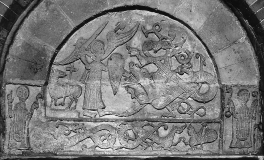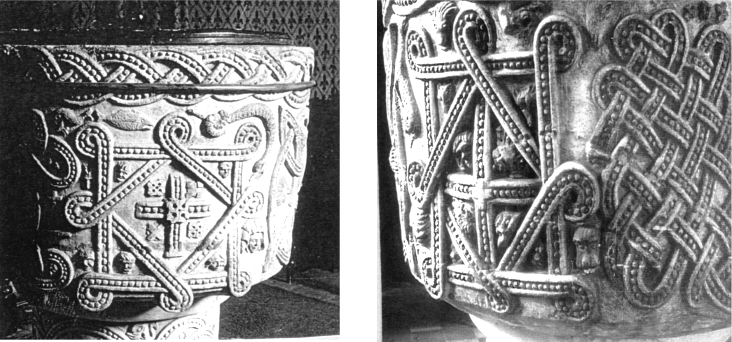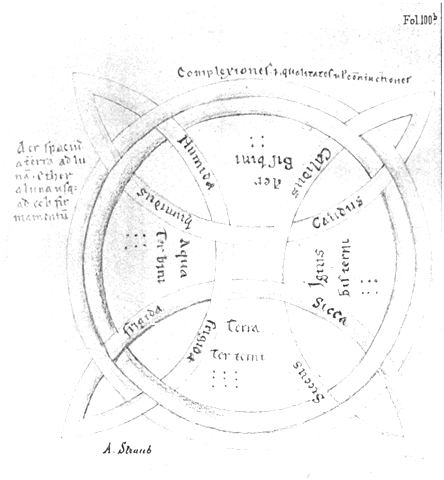
Interpreting 12th-century sculpture in English churches




Geometric designs in early medieval carvings and manuscripts
Intricate diagrams consisting of interwoven circles, loops and other figures are common on sculpted fonts and tympana in twelfth century churches, in illuminated manuscripts and even on Greek and Roman pavements.
Are these designs intended as mere decoration, or could they have meaning? Mary Curtis Webb contended that the diagrams are indeed profoundly meaningful. They indicate in symbolic form the ancient Pythagorean / Platonic Theory of Number as the basis of the cosmos.
Early Christian theologians, wishing to amplify or to illustrate the account in Genesis, adopted the Theory of Number from neo-Platonist philosophers, who in turn had elaborated the teachings of Plato and the Pythagoreans on the basis of Christian speculation.
Such cosmological designs can be found in manuscript copies of Boethius’ translation of Introduction to Arithmetic by Nicomachus of Gerasa. This book, written in the first century AD, is concerned less with mathematics as such, but rather with the nature of the universe.
A FINE EXAMPLE OF THE TRANSMISSION OF GREEK COSMOLOGY TO 12th CENTURY ENGLAND
The persistence of Platonic cosmology and Pythagorean arithmetical theories in the studies of the Quadrivium is underlined by this drawing from a manuscript produced at Christ Church Cathedral Priory, Canterbury c.1150. It shows, at bottom right, Nicomachus of Gerasa (1st century AD) with Boethius, his translator, discussing musical harmony with Pythagoras (top right) and Plato (bottom left).
Plato's Timaeus was the ultimate source of those cosmological theories which, in the twelfth century, were used to provide a 'scientific basis' for Christian theories of the Creation. Boethius' Latin translation of the Arithmetical Primer (written c.100 by the Pythagorean, Nicomachus of Gerasa) supplied the Middle Ages with the sole text book available on the subject in the schools. This drawing was made during the Platonist revival, contemporaneously with the work of scholarly Chancellors of the Cathedral School of Chartres such as Thierry (d.1155) and Gilbert de la Porrée (d.1154) and before the full recovery of the Aristotelian corpus.
Cambridge University Library

Christian theologians such as Isidore of Seville and Bede adopted these expositions of the Creation. Similar designs are to be found in manuscripts of their works, and in numerous other works, kept in monastic libraries of the twelfth century.
The 12th century font made for the church of Hampstead Norreys (now in the church of Stone, Buckinghamshire) provides an example. On one side of the font, we have a sculpted pictorial representation of God’s WORK OF SALVATION as expounded by Gregory the Great in his Commentary on the Book of Job, the Moralia in Job. On the other side of the font we find God’s WORK OF CREATION, depicted in four elaborate designs.
These wonderful geometric designs are cosmological schemata whose ultimate source is Plato’s Timaeus. Their general purport is the harmony of the four elements in the Macrocosm and the Microcosm.


The 12th century Font from Hampstead Norreys
The CREATION OF THE WORLD - clockwise, from top left:
SQUARE ON A SQUARE: the perfection of number, a cube represented as two superimposed squares.
RHOMB ON AN OBLONG: probably harmonic proportion, reconciling good and evil.
CIRCLE with its arcs double-looped: probably the Microcosm.
CIRCLE interlaced with its arcs: the Macrocosm with the four elements.
Theologians of the School of Paris unfolded their intellectual vision of Harmony in Number at the heart of Creation. The Harmony of the Macrocosm (the Universe) is reflected in that of the Microcosm (Man and his humours).
Geometric designs similar to those on the Hampstead Norreys font are to be found on fonts and on pavements, in manuscripts and elsewhere. These illustrations show a few examples of the different designs.

The harmony of the created universe
A cosmological diagram from Abbess Herrad's Hortus Deliciarum, written c. 1167 – 1195, showing the cyclical interaction of the qualities of the Four Elements as described in Plato’s Timaeus.
“... God when putting together the universe, made it of Fire and Earth. But it is not possible to combine two things properly without a third to act as a bond to hold them together. The best bond is one that effects the closest unity between itself and the terms it is combining; and this is best done by continued geometric proportion ... So God placed Air and Water between Fire and Earth, and made them so far as possible proportional to one another, so that Air is to Water as Water is to Earth, and in this way He bound the world into a visible and tangible whole. So by this means and from these four constituents the body of the universe was created to be at unity, owing to proportion; in consequence it acquired concord ...."
Plato. Timaeus 31b 31c
"... A suitable shape for a living being that was to contain all living beings would be a figure that contains all possible figures within itself. Therefore He turned it into a rounded spherical shape, with extremes equidistant in all directions from the centre. It was designed to supply its own nourishment from its own decay, and to comprise and cause all processes ..."
Plato. Timaeus 33.34
Warburg Institute photo